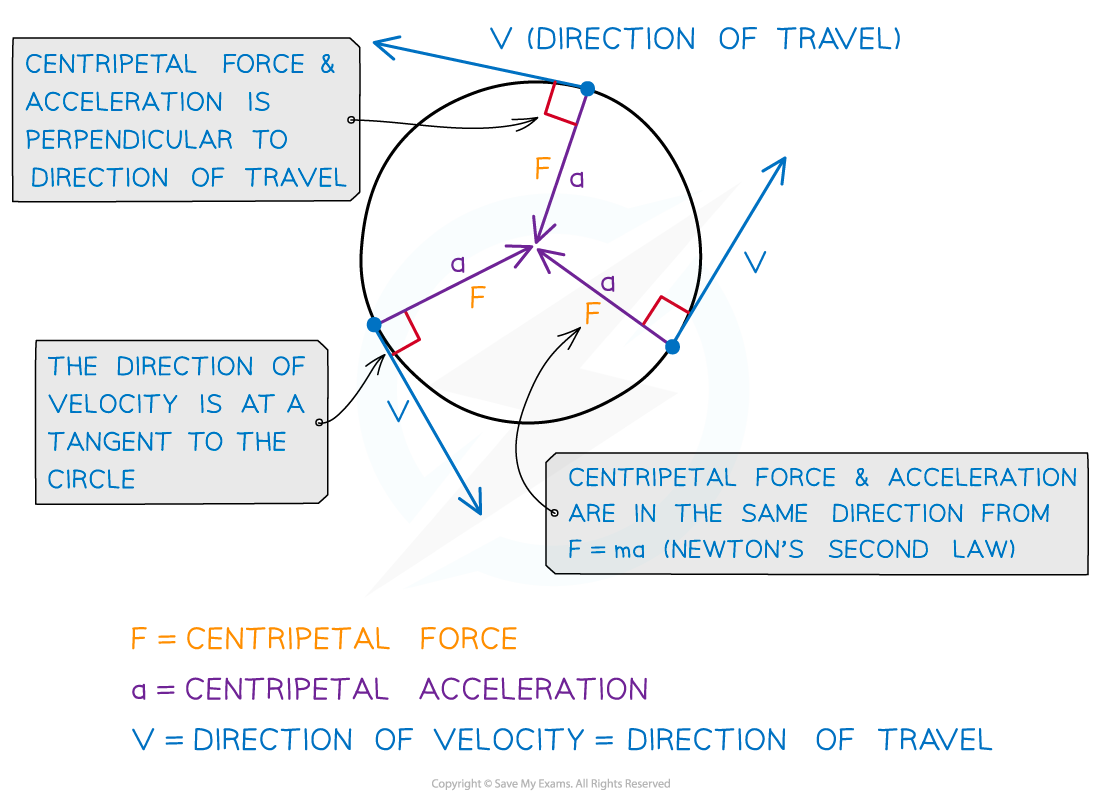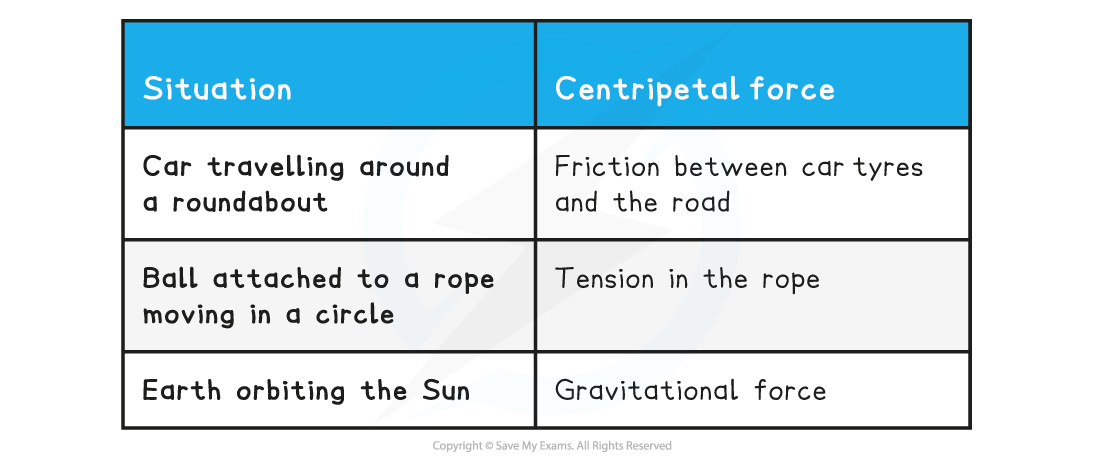Centripetal Force (DP IB Physics) : Revision Note
Centripetal Force
Velocity and acceleration are both vector quantities
An object in uniform circular motion is continuously changing direction, and therefore is constantly changing velocity
The object must therefore be accelerating
This is called the centripetal acceleration and is perpendicular to the direction of the linear speed
Centripetal means it acts towards the centre of the circular path
From Newton's second law, this must mean there is a resultant force acting upon it
This is known as the centripetal force and is what keeps the object moving in a circle
This means the object changes direction even if its magnitude of velocity remains constant
The centripetal force (F) is defined as:
The resultant force perpendicular to the velocity required to keep a body in a uniform circular motion which acts towards the centre of the circle
The magnitude of the centripetal force F can be calculated using:
Where:
F = centripetal force (N)
v = linear speed (m s−1)
⍵ = angular speed (rad s−1)
r = radius of the orbit (m)

Centripetal force is always perpendicular to the linear velocity (i.e, the direction of travel)
The direction of the centripetal force is:
In the same direction as the centripetal acceleration (towards the centre of the circle)
This is due to Newton's Second Law
Perpendicular to the linear velocity
The centripetal force is not a separate force of its own
It can be any type of force, depending on the situation, which keeps an object moving in a circular path
For example, tension, friction, gravitational, electrostatic or magnetic
Examples of centripetal force

When solving circular motion problems involving one of these forces, the equation for centripetal force can be equated to the relevant force equation
For example, for a mass orbiting a planet in a circular path, the centripetal force is provided by the gravitational force
When an object travels in circular motion, there is no work done
This is because there is no change in kinetic energy
Horizontal Circular Motion
An example of horizontal circular motion is a vehicle driving on a curved road
The forces acting on the vehicle are:
The friction between the tyres and the road
The weight of the vehicle downwards
In this case, the centripetal force required to make this turn is provided by the frictional force
This is because the force of friction acts towards the centre of the circular path
Since the centripetal force is provided by the force of friction, the following equation can be written:
Where:
m = mass of the vehicle (kg)
v = speed of the vehicle (m s–1)
r = radius of the circular path (m)
μ = static coefficient of friction
g = acceleration due to gravity (m s–2)
Rearranging this equation for v gives:
This expression gives the maximum speed at which the vehicle can travel around the curved road without skidding
If the speed exceeds this, then the vehicle is likely to skid
This is because the centripetal force required to keep the car in a circular path could not be provided by friction, as it would be too large

The frictional force provides the centripetal force
Therefore, in order for a vehicle to avoid skidding on a curved road of radius r, its speed must satisfy the equation
A mass attached to a string rotating around is another example of horizontal circular motion
In this case, the tension is the centripetal force as it acts towards the centre of the circle
This time, the weight of the mass will be acting as well as the tension of the string

A mass attached to a string will have its weight acting meaning the string is at an angle
The weight mg of the mass needs to be balanced by the vertical component of the tension
This means the string will always be at an angle and never perfectly horizontal
The ball's linear velocity, v is still perpendicular to the tension and its weight, mg points downward
All three forces are perpendicular to each other, so no other component contributes to the centripetal force, just the tension
The centripetal force is still towards the centre of the circle, but now is just the horizontal component of the tension
This is an important example of resolving vectors properly. The vertical component does not always have 'sinθ', it depends on what θ is defined as
Banking
A banked road, or track, is a curved surface where the outer edge is raised higher than the inner edge
The purpose of this is to make it safer for vehicles to travel on the curved road, or track, at a reasonable speed without skidding
When a road is banked, the centripetal force no longer depends on the friction between the tyres and the road
Instead, the centripetal force depends solely on the horizontal component of the normal force

During banking, the horizontal component of the normal reaction force provides the centripetal force
Worked Example
A 300 g ball is made to travel in a circle of radius 0.8 m on the end of a string. If the maximum force the ball can withstand before breaking is 60 N, what is the maximum speed of the ball?
Answer:
Step 1: List the known quantities
Mass, m = 300 g = 300 × 10-3 kg
Radius, r = 0.8 m
Resultant force, F = 60 N
Step 2: Rearrange the centripetal force equation for v
Step 3: Substitute in the values
12.6 m s–1
Examiner Tips and Tricks
The linear speed, v is sometimes referred to as the ‘tangential’ speed.
The centripetal force equation is not given in your data book, but you are given in the equations for centripetal acceleration. You just need to multiply them by mass m since the centripetal force F = ma.
It is important you understand the foundations of circular motion, especially how to use the equations. This will heavily link with kepler's laws and magnetic fields.

You've read 0 of your 5 free revision notes this week
Sign up now. It’s free!
Did this page help you?
